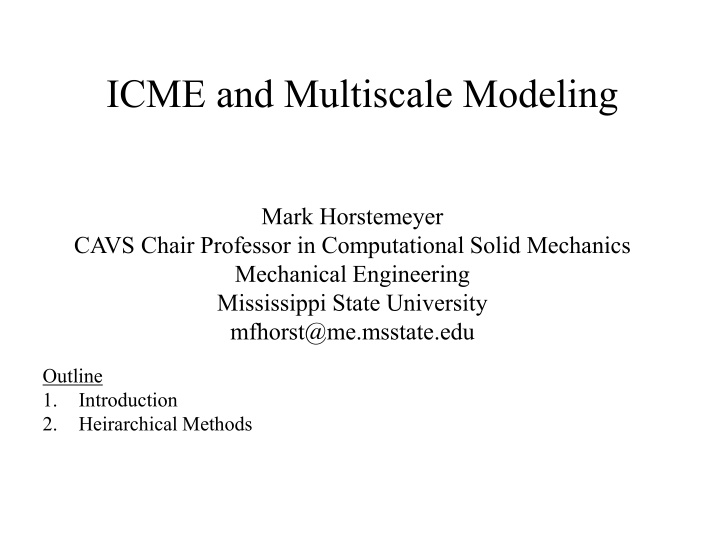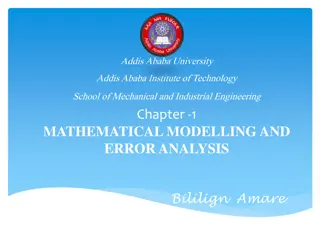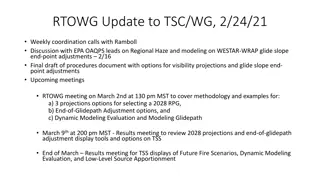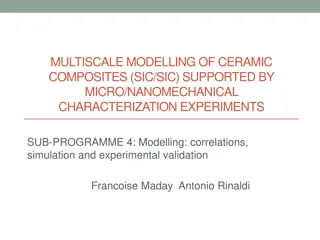
Advanced Multiscale Modeling and ICME Applications
The advantages of employing Integrated Computational Materials Engineering (ICME) in design, guidelines for multiscale bridging, and various disciplines and bridges in multiscale modeling. Enhance your understanding of hierarchical methods and concurrent continuum solid mechanics for efficient virtual design optimization and material innovation.
Download Presentation

Please find below an Image/Link to download the presentation.
The content on the website is provided AS IS for your information and personal use only. It may not be sold, licensed, or shared on other websites without obtaining consent from the author. If you encounter any issues during the download, it is possible that the publisher has removed the file from their server.
You are allowed to download the files provided on this website for personal or commercial use, subject to the condition that they are used lawfully. All files are the property of their respective owners.
The content on the website is provided AS IS for your information and personal use only. It may not be sold, licensed, or shared on other websites without obtaining consent from the author.
E N D
Presentation Transcript
ICME and Multiscale Modeling Mark Horstemeyer CAVS Chair Professor in Computational Solid Mechanics Mechanical Engineering Mississippi State University mfhorst@me.msstate.edu Outline 1. 2. Introduction Heirarchical Methods
Six Advantages of Employing ICME in Design 1. ICME can reduce the product development time by alleviating costly trial-and error physical design iterations (design cycles) and facilitate far more cost-effective virtual design optimization. 2. ICME can reduce product costs through innovations in material, product, and process designs. 3. ICME can reduce the number of costly large systems scale experiments. 4. ICME can increase product quality and performance by providing more accurate predictions of response to design loads. 5. ICME can help develop new materials. 6. ICME can help medical practice in making diagnostic and prognostic evaluations related to the human body.
Eight Guidelines for Multiscale Bridging 1. Downscaling and upscaling: Only use the minimum required degree(s) of freedom necessary for the type of problem considered Downscaling and upscaling: energy consistency between the scales Downscaling and upscaling: verify the numerical model s implementation before starting calculations Downscaling: start with downscaling before upscaling to help make clear the final goal, requirements, and constraints at the highest length scale. Downscaling: find the pertinent variable and associated equation(s) to be the repository of the structure-property relationship from subscale information. Upscaling: find the pertinent effect for the next higher scale by applying ANOVA methods Upscaling: validate the effect by an experiment before using it in the next higher length scale. Upscaling: Quantify the uncertainty (error) bands (upper and lower values) of the particular effect before using it in the next higher length scale and then use those limits to help determine the effects at the next higher level scale. 2. 3. 4. 5. 6. 7. 8.
Multiscale Modeling Disciplines atoms grains electrons dislocations retain only the minimal amount of information Concurrent continuum Solid Mechanics: Hierarchical Numerical Methods: Concurrent Materials Science: Hierarchical Physics: Hierarchical Mathematics: Hierarchical and Concurrent Hierarchical
Bridge 13 = FEA ISV Bridge 12 = FEA Macroscale ISV Continuum Macroscale ISV Continuum Bridge 11 = void-crack interactions Bridge 10 = Void \ Crack Growth Crystal Plasticity (ISV + FEA) 100-500 m Bridge 5 = Particle- Void Interactions Crystal Plasticity (ISV + FEA) Bridge 9 = Void \ Crack Nucleation 10-100 m Bridge 4 = Particle Interactions Crystal Plasticity (ISV + FEA) Bridge 8 = Dislocation Motion m Bridge 7 = High Rate Mechanisms Bridge 3 = Hardening Rules Dislocation Dynamics (Micro-3D) 100 s Nm Bridge 2 = Mobility Bridge 6 = Elastic Moduli Nm Atomistics (EAM,MEAM,MD,MS, Bridge 1 = Interfacial Energy, Elasticity Electronics Principles (DFT)
Multiscale Experiments 1. Exploratory exps 2. Model correlation exps 3. Model validation exps Structural Scale FEM Experiments Nanoscale Macroscale Continuum Model Cyclic Plasticity Damage Model Analysis Fracture Experiment Uniaxial/torsion Notch Tensile Fatigue Crack Growth Cyclic Plasticity Cohesive Energy Critical Stress Interface Debonding FEM Analysis Torsion/Comp Tension Monotonic/Cyclic Experiment TEM Microscale ISV Model Void Nucleation Mesoscale IVS Model Void Growth Void/Void Coalescence Void/Particle Coalescence Experiment SEM Optical methods ISV Model Void Growth Void/Crack Nucleation FEM Analysis Idealized Geometry Realistic Geometry Experiment Fracture of Silicon Growth of Holes Fem Analysis Idealized Geometry Realistic RVE Geometry Monotonic/Cyclic Loads Crystal Plasticity
Design Optimization Optimization under Uncertainty Analysis Design Options Product & Process Performance (strength, reliability, weight, cost, manufactur- ability ) Multiscales Product (material, shape, topology) Process (method, settings, tooling) Optimal Product Process Design Objective & Constraints Modeling Experiment FEM Analysis Environment (loads, boundary conditions) Preference & Risk Attitude Cost Analysis
CyberInfrastructure IT technologies (hidden from the engineer) Conceptual design process (user-friendly interfaces) Engineering tools (CAD, CAE, etc.)
macroscale continuum y y^ x x ^ subscale piecewise continuous with discrete entities






















